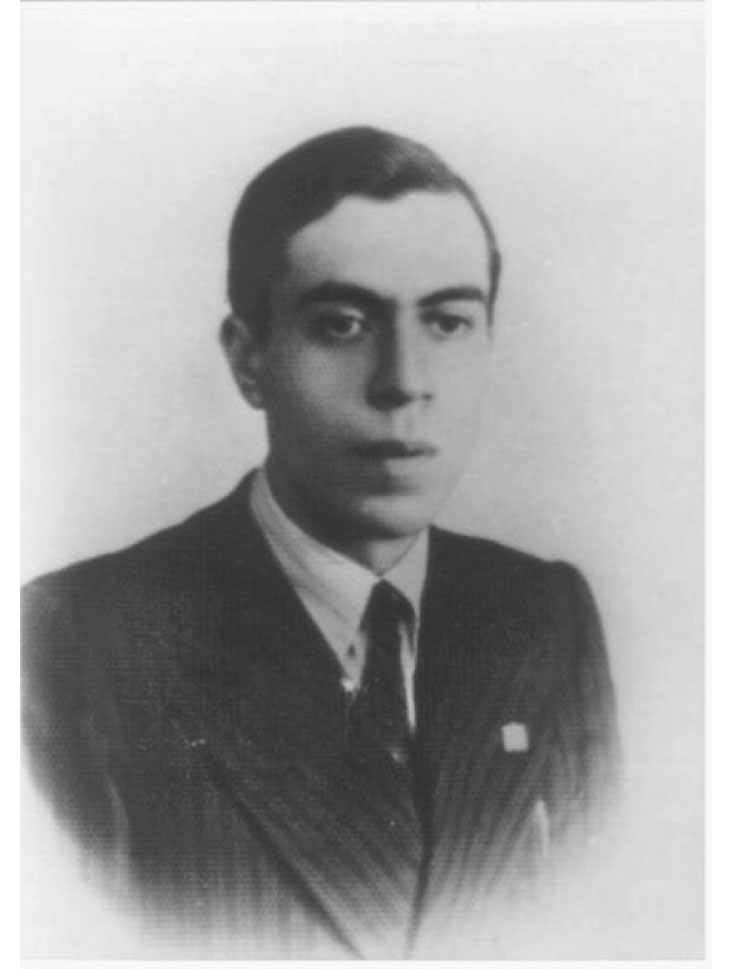The members of the physics institute at Via Panisperna were in the habit of giving themselves jocular nicknames: Enrico Fermi was “The Pope,” Orso Corbino was “God the Almighty,” and Franco Rasetti was “The Cardinal Vicar.” It was 1930, and the Italian capital boasted a miraculous collection of scientists on their way to revolutionizing atomic and nuclear physics. Not since Galileo had Italy shown such scientific prominence. The team of mavericks became known as the “Via Panisperna Boys,” and was led by the now-celebrated Enrico Fermi, at the time in his 20s and already a full professor. But many of its other names will also sound familiar to present-day physics students: Wick, Racaha, Segrè, Pontecorvo…
As usually happens with such wondrous groups, it was born out of serendipity, the fortuitous confluence of talented people and visionary politicians. The latter came in the form of a Mafioso protector, Senator Corbino, who was powerful enough to keep science bureaucrats and Mussolini’s quirks at bay. Thus sheltered from the real world, the Boys did science in that atmosphere of pranks, jokes, and informality present in every high-intensity scientific establishment, an intellectual ambience popularized in “Surely You’re Joking, Mr. Feynman.” The Via Panisperna Institute was the sort of scientific kindergarten capable of nurturing truly creative thinking, where serious issues blended with bets on who could solve differential equations fastest. These, incidentally, were always won by “Il Grande Inquisitore”—Ettore Majorana.
Ettore Majorana was one of the oddballs of the group. A child prodigy, capable of doing cubic roots in his head as a kid, he carried into adulthood the concomitant problems in relating to others—and very pertinently to women—ensuring the prerequisite internal pool of frustrations essential for lateral thinking. Majorana was reared within a dysfunctional high-flying family, ruled over by an overbearing and domineering mother, who towered over his generation. He hailed from Sicily, a land well known for its artistic prowess, but also for an almost complete lack of scientific talent (not to mention an ingrained suspicion about science, and a preference for superstition). Later in life, already an established scientist, Majorana was quite unlike his colleagues, who typified the cliché of the scientist-philistine. Majorana was well versed in Pirandello and Schopenhauer, and had interests outside science beyond the standard-issue hobbies, particularly in literature and philosophy. He was what nowadays might be called a renaissance man.
He was feared and respected by peers and professors alike, but he was also adrift.
After his family moved to Rome, Majorana enrolled in an engineering program, where he proved to be the ultimate nightmare for his teachers, given his ability to do mathematics in his head and spot inconsistencies at first sight. He was feared and respected by peers and professors alike, but he was also adrift, never studying or showing any interest in what he was supposed to be doing. In his early days, Einstein shared this aloofness, this disengagement from the world, before age and maturity brought about the massive explosion of creativity for which both became known. In Majorana’s case his opportunity to flourish was served up on a silver tray, in the shape of Via Panisperna.
Each of the Via Panisperna boys did both experimental and theoretical work, with the exception of Majorana, who never dirtied his hands in the lab. Majorana was more mathematically inclined, and contented himself with turning up late at the Institute, sitting aside, pointing out embarrassing errors “at sight,” and then proposing theories that would hit the mainstream of physics only decades later. It was while installed in his niche as a feared out-of-the-box thinker within the Panisperna Boys that Majorana became interested in symmetry, and its central mathematical tool, group theory.

Particles and anti-particles are way too similar not to be related by symmetry. Consider the electron and the positron (or the anti-electron). Where they are not exactly identical (they have the same mass and spin) they are the precise opposite (for example, their electric charge has the same value but opposite sign). Years after Majorana, Richard Feynman and Ernst Stueckelberg were the first to understand that this uncanny similarity could be understood as a symmetry under the reversal of the arrow of time.
Suppose we started playing the film of the world backward in time. Within our human experience the result would be utter nonsense. Even children’s stories would be preposterous: Having lived happily for ever before, one day the Prince would bestow a kiss upon the Princess, making her fall promptly into a deep coma, after which he’d forget about her and go hunting. Sleeping Beauty would then wake up at random years later near a spindle, followed by more incomprehensible garbage… what a lousy story for putting children to bed!
But for simple (as opposed to complex) physics systems the fairy tale would by and large remain unchanged. If we imagine a Solar System where all the velocities had been reversed, leading to a “backward in time” movie, it would all pretty much still work out. The length of the year for Earth and other planets would be the same. The sun would rise in the West and set in the East, but the duration of the day would be no different. Likewise, the world of sub-atomic particles undergoes remarkably simple changes under the reversal of the arrow of time. Specifically, particles are converted into anti-particles and vice versa (see Not a Prank).
When Majorana was active at Via Panisperna, the role of time-reversal in particle physics was not known and anti-particles, as they were then understood, brought with them a whole gamut of oddities. Paul Dirac had just discovered them a few years prior, in 1928, in a treatment that remains a historical peculiarity. He had set out to unify quantum mechanics and special relativity, and had discovered the simplest, rather than the most obvious group theory construction that did so. As a corollary it contained anti-matter. But in his theory the vacuum had to be defined as an infinite sea of particles with negative energy, and this infinite sea was postulated to be unobservable. The theory also predicted the creation and annihilation of particles of matter and anti-matter, but these processes were deemed esoteric and belonging to the realm of science fiction rather than real science. The community remained ambiguous about the success of Dirac’s theory.
Majorana didn’t like anti-particles either. His career started before they were experimentally discovered, and even before infinite vacuum seas and annihilations are considered, the nitty-gritty details of the mathematics of anti-particles displeased him. Scientists are often led by hunches and matters of taste: While we suppose that nature’s beauty has a universal appeal, it is often first a gleam in the eye of the beholder. He therefore put all the weight of his not inconsiderable mathematical skills behind an attempt to circumvent the prediction of anti-matter. His agenda was to achieve the same unification that Dirac had achieved, between relativity and quantum mechanics, but without generating anti-particles.
The result would be the now-famous Majorana neutrino. Its construction was more complex than Dirac’s, but also logically a far more obvious extension of existing theories. Where Dirac went for simplicity, Majorana went for logic minimalism. His new particle was its own anti-particle, and therefore did not require inventing any new anti-particles. It can be understood by blending the Feynman-Stueckelberg picture (which came after Majorana) with the idiosyncrasies of Schrödinger’s cat. If quantum mechanics allows for the eerie superposition of a live and dead cat, it also permits the superposition of the two arrows of time. Cat and anti-cat can be folded into one, or to leave felines out of this, one may set up a perfectly symmetric superposition of neutrino and anti-neutrino. The Majorana neutrino travels both forward and backward in time, in equal amounts, and therefore remains unchanged if we play its film backward in time.
His new particle allowed Majorana to avoid the awkward aspects of Dirac’s anti-world. If nature were as simple as possible, all particles should have been Majorana particles, and anti-particles would not exist. Nature, however, is what it is, and regarding the electron Dirac was right and Majorana wrong. The positron (or anti-electron) was discovered by Carl David Anderson in cosmic rays in 1933. But as Dirac himself once noted, it is often the case that “the opposite of a profound truth may well be another profound truth.”

No one around Majorana even remotely understood what he was up to: the other Boys, for all their gifts, were much more down-at-heel. Like most physicists at the time, they regarded Majorana’s constructions as pure mathematics, without any relevance to physics. Applying group theory to physical problems, as Majorana had done, was just embellishment, or as the English like to say, “over-egging the pudding.”
Majorana didn’t care. Part of his strength was a sense of self-deprecation with which he smeared everything he did; indeed he was even more negative about his own ideas than about the others.’ He could try out unusual avenues because he didn’t take himself seriously, and so wasn’t constrained by a fear of failure. In a letter to a friend regarding his early efforts on symmetry and its toolbox, he said, “As for myself I do nothing sensible. That is, I study group theory with the firm intention of learning it, similar in this to that Dostoyevsky character who started one day to set aside his small change, fully persuaded that soon he’d be rich like Rothschild.”
It was the beginning of a gradual and terminal estrangement from his colleagues. Majorana was very bad at joining the usual science mafias that ensure a trouble-free career for any sensible scientist. Writer Leonardo Sciascia once said that Majorana “like all ‘good’ Sicilians” was averse to being a part of any group, or to establishing teams or partnerships. At Via Panisperna he was never properly one of the boys. It was for a good reason they called him The Grand Inquisitor. He spotted errors and deficiencies like no one else, and phrased his views as sharp and derogatory criticisms. People felt they were at the merciless hands of the Inquisition when he was nearby, and this took its toll in the resentment it induced in others.
But if he was critical of the others he was even tougher on himself. In his eyes his theories and ideas were never good enough. Self-deprecation is a difficult card to play—a bit of ego indulgence might have worked wonders in his darker moments. For years he’d exasperated everyone by having brilliant ideas but then refusing to publish them. In a community where “publish or perish” has always been the mantra, he couldn’t care less about his article count. Where his colleagues were obsessed with priority disputes, he laughed them off.
For the next four years, he would hardly leave his bedroom, requesting only a daily tray of food, which dwindled to little more than some milk.
Nor did it help that most people found him sad and depressive. His sense of humor was almost British—subtle but ultimately caustic and antiestablishment. He had serious problems making friends and was ultimately a loner. This was partly fallout from his child prodigy past, where he was paraded before visitors doing cubic roots in his head, and wasn’t allowed to play with other kids so as to follow the demanding program of studies designed by his father. The line between Mozartian grandeur and child abuse can be very blurry indeed.
With regards to women, he suffered from an inferiority complex. As his friend Gaston Piqué said in an interview: “Because beautiful, properly, he wasn’t; indeed, he was rather ugly. And… there was a girl… a very intelligent girl, and this young man, so prodigious, such a genius, truly attracted her. But he did nothing, even avoided her, because he was a victim of his inferiority complex…” As one of his relatives once stated: “Love would have made all the difference.” But it was not to be.
Something finally snapped inside Majorana around 1933. For the next four years, he would hardly leave his bedroom, requesting only a daily tray of food, which dwindled to little more than some milk. He had entered his own anti-world. This kind of behavior is not unusual in people who’ve fallen into severe depression. The Japanese coined a term for them: hikikomori, the modern-day hermits. Over his years of seclusion, family and friends just let him be. Any kind of treatment or counseling would have been an anachronism at that time, and he may not have even accepted it. Scientists and artists are famous for cherishing rather than resolving their hang-ups. Psychotherapy would have been seen as throwing the baby out with the bathwater. In the end both baby and bathwater were ejected from reality in a spectacular manner.
In January 1938 Majorana took up a professorship at Naples University. In what must have felt like a last-ditch effort to return to the world, he entered a prestigious academic competition, surprising everyone at Via Panisperna, who hadn’t heard from him for years. His entry included his now-famous paper on the Majorana particle. After some political contortions, related to his unusual circumstances, he was awarded a Chair “by exceptional merit.” At first, his life in Naples displayed a superficial semblance of normality. But a storm was brewing below the surface. It is hard to trace in depth his last three months, other than to glean a smattering of clues showing that things were actually going severely wrong on several fronts. There is even evidence that he fell in love with one of his students, a beautiful woman by the name of Gilda Senatore. It was unrequited love, that much is obvious. She was the last person to see him.
Proving that neutrinos are Majorana particles would have dramatic implications for our understanding of symmetry in the natural world.
On the night of March 25, 1938, Majorana boarded a ship and was never seen again. He left behind a series of very odd notes, which may be perceived as suicide letters, but he also took with him the equivalent of $75,000 in present-day money as well as his passport. His body was never recovered. Over the years he was “sighted” on numerous occasions, leading to endless conspiracy theories. His psychology remains far more interesting, but less studied.
What has been most studied, and is today Majorana’s lasting legacy, is the mathematical formulation he left behind. Editions of Wigner’s masterpiece Group Theory and its Application to the Quantum Mechanics of Atomic Spectra start carrying references to Majorana from the 1940s onwards. But it was not until the 1960s that physicists started thinking of fundamental theories of nature in terms of symmetries and group theory, and Majorana’s full contribution was recognized. In 1982 Pontecorvo, one of the Via Panisperna boys, wrote “in the ’50s and in the ’60s the opinion was frequently expressed that neutrinos a la Majorana, although beautiful and interesting objects, are not realized in nature; … [things have changed] and the question raised by Majorana is now the central question in neutrino physics.” Soon afterward a massive international search for the Majorana neutrino started, focused on a process called neutrinoless double beta decay, which is an unambiguous hallmark of Majorana neutrinos. Nowadays this hunt involves about a dozen international collaborations combining the efforts of hundreds of physicists, and Majorana’s name can be recognized in the acronym of many of them, such as NEMO (which stands for Neutrino Ettore Majorana Observatory).
Proving that neutrinos are Majorana particles would have dramatic implications for our understanding of symmetry in the natural world, and represents one of the final outstanding debates in the Standard Model of the elementary particles. A leading contender for next-generation particle model relies on supersymmetry, which posits that every fermion has a corresponding boson. Supersymmetry is more likely to be true if neutrinos are Majorana particles. In solid-state physics, too, mathematical analogues of Majorana particles are being studied and have already been found.
As for its creator, the riddle will never be broken. We are left with the story of a creator and a particle which are strangely parallel, the particle providing the perfect metaphor for its creator’s eventual disappearance. On the outer wall of the house where Majorana was born, in Catania, a plaque reads: “His timid and solitary genius scrutinized and illuminated the secrets of the universe with the blaze of a meteor that too soon evaporated in March 1938, leaving us the mystery of his thinking.” Majorana was only 31 years old at the time of departure. Or arrival, as the case may be.
João Magueijo is a professor of theoretical physics at Imperial College, and works in cosmology and quantum gravity. He was a pioneer of the varying speed of light theory, and his work has often focused on “varying constant” models of the early universe.


























